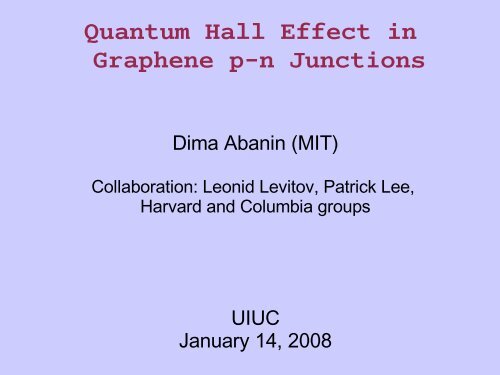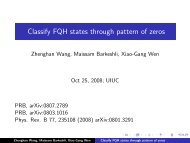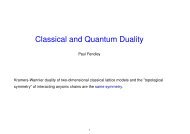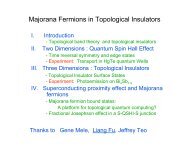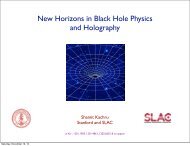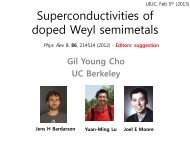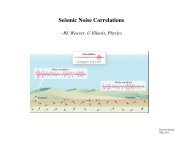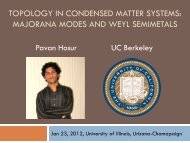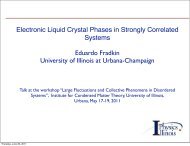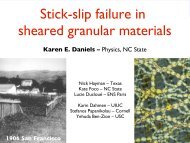Quantum Hall Effect in Graphene p-n Junctions
Quantum Hall Effect in Graphene p-n Junctions
Quantum Hall Effect in Graphene p-n Junctions
You also want an ePaper? Increase the reach of your titles
YUMPU automatically turns print PDFs into web optimized ePapers that Google loves.
<strong>Quantum</strong> <strong>Hall</strong> <strong>Effect</strong> <strong>in</strong><br />
<strong>Graphene</strong> p-n <strong>Junctions</strong><br />
Dima Aban<strong>in</strong> (MIT)<br />
Collaboration: Leonid Levitov, Patrick Lee,<br />
Harvard and Columbia groups<br />
UIUC<br />
January 14, 2008
Electron transport <strong>in</strong><br />
graphene monolayer<br />
New 2d electron system (Manchester 2004):<br />
Nanoscale system with tunable transport properties;<br />
Field-effect enabled by gat<strong>in</strong>g:<br />
conductivity l<strong>in</strong>ear <strong>in</strong> density,<br />
mobility, density vs gate voltage<br />
holes<br />
electrons<br />
Andrey Geim<br />
Monolayer<br />
graphene<br />
Philip Kim<br />
Novoselov et al, 2004, Zhang et al, 2005
Electronic Properties<br />
Semimetal (zero bandgap)<br />
Massless Dirac electrons<br />
K<br />
position space<br />
momentum space<br />
K'<br />
1) Two species of Dirac fermions – valleys K, K';<br />
2) Components of Dirac sp<strong>in</strong>or=amplitudes on sublattices A and B.
The “half-<strong>in</strong>teger” QHE <strong>in</strong> graphene<br />
S<strong>in</strong>gle-layer graphene:<br />
QHE plateaus observed at<br />
Double-layer<br />
(non-Dirac):<br />
one layer (Dirac):<br />
4=2x2 sp<strong>in</strong> and valley degeneracy<br />
Manifestation of Dirac<br />
nature of excitations!<br />
Particle-hole symmetry<br />
Novoselov et al, 2005, Zhang et al, 2005
QHE <strong>in</strong> graphene: Landau<br />
levels<br />
To obta<strong>in</strong> LL's use relation HPauli-Schroed<strong>in</strong>ger =2m(HDirac)^2
Some <strong>in</strong>terest<strong>in</strong>g aspects of<br />
QHE <strong>in</strong> graphene<br />
1) Electron-hole symmetric zeroth LL;<br />
2) Atomically sharp edge;<br />
3) Valley+sp<strong>in</strong> spontaneous symmetry break<strong>in</strong>g<br />
(similarity to QH bilayers);<br />
4) Large gaps between Landau levels --> room-T QHE<br />
5) Possibly new electron QHE phases (fractional,stripe...)
Plan<br />
1) <strong>Quantum</strong> <strong>Hall</strong> edge states <strong>in</strong> graphene<br />
2) Sp<strong>in</strong>-filtered edge states at the Dirac po<strong>in</strong>t:<br />
transport properties<br />
3) Fractional conductance quantization <strong>in</strong> gated<br />
graphene devices
QHE: edge transport (rem<strong>in</strong>der)<br />
Chiral dynamics<br />
along edge<br />
(unidirectional)
<strong>Graphene</strong> QHE: edge states<br />
Counter-propagat<strong>in</strong>g electron<br />
and hole states;<br />
Symmetric splitt<strong>in</strong>g of n=0 LL<br />
Universality, same for<br />
other edge types;<br />
The odd numbers of edge modes<br />
result <strong>in</strong> half-<strong>in</strong>teger QHE<br />
armchair edge<br />
Edge states from 2d Dirac model<br />
DA, Lee, Levitov, PRL 96, 176803 (2006)<br />
Also: Peres, Gu<strong>in</strong>ea, Castro-Neto, 2005, Brey and Fertig, 2006<br />
zigzag<br />
edge<br />
(similar,<br />
+surface<br />
states)
Sp<strong>in</strong>-filtered edge states for<br />
Zeeman-split Landau levels<br />
Near ν=0, E=0:<br />
(i) Two chiral counter-propagat<strong>in</strong>g<br />
edge states with opposite sp<strong>in</strong><br />
polarizations<br />
(ii) No charge QHE, but<br />
quantized sp<strong>in</strong> <strong>Hall</strong> effect.<br />
DA, Lee, Levitov, PRL 96, 176803 (2006); Solid State Comm. 143, 77 (2007).
Estimate of the sp<strong>in</strong> gap<br />
Exchange <strong>in</strong> sp<strong>in</strong>-degenerate LL's at ν=0, E=0:<br />
Coulomb <strong>in</strong>teraction favors sp<strong>in</strong> polarization;<br />
Fully antisymmetric spatial many-electron wavefunction;<br />
Sp<strong>in</strong> gap dom<strong>in</strong>ated by the exchange<br />
somewhat reduced by correlation energy:<br />
correlation<br />
Gives sp<strong>in</strong> gap ~100K much larger than Zeeman energy (10K)<br />
Exchange-enhanced gap not observed (Yet?)
Sp<strong>in</strong>tronics <strong>in</strong> graphene: chiral<br />
sp<strong>in</strong> edge transport<br />
Charge current<br />
Sp<strong>in</strong> current<br />
(Landauer-Buttiker)<br />
A 4-term<strong>in</strong>al device,<br />
full sp<strong>in</strong> mix<strong>in</strong>g <strong>in</strong> contacts<br />
In an ideal clean system (no <strong>in</strong>ter-edge sp<strong>in</strong>-flip scatter<strong>in</strong>g):<br />
charge current along V, sp<strong>in</strong> current transverse to V:<br />
Quantized sp<strong>in</strong> <strong>Hall</strong> conductance
Sp<strong>in</strong>-filtered transport<br />
Asymmetric backscatter<strong>in</strong>g filters one sp<strong>in</strong> polarization,<br />
creates longitud<strong>in</strong>al sp<strong>in</strong> current:<br />
<strong>Hall</strong> voltage measures sp<strong>in</strong> not charge current!<br />
Applications: (i) sp<strong>in</strong> <strong>in</strong>jection; (ii) sp<strong>in</strong> current detection.<br />
Sp<strong>in</strong> current without ferromagnetic contacts
Sp<strong>in</strong>-flip scatter<strong>in</strong>g of edge<br />
states<br />
Can be due to potential edge disorder+SO:<br />
--Sp<strong>in</strong>-orbit:<strong>in</strong>tr<strong>in</strong>sic+Rashba<br />
-Only Rashba term (~1K) is effective<br />
-Edge disorder with length scale d~1nm<br />
-Gives mean free path:<br />
where is detun<strong>in</strong>g from cross<strong>in</strong>g<br />
-Typical values l~10 m at 10 K comparable to sample size
What symmetry protects gapless<br />
edge states?<br />
Gapless states, e.g. sp<strong>in</strong>-split<br />
Gapped states, e.g. valley-split<br />
Special Z2 symmetry requirements (Fu, Kane, Mele, 2006):<br />
<strong>in</strong> our case, the Z2 <strong>in</strong>variant is Sz that commutes with H;
Manifestations <strong>in</strong> transport<br />
near the neutrality po<strong>in</strong>t<br />
Gapless sp<strong>in</strong>-polarized states:<br />
a) Longitud<strong>in</strong>al transport of 1d character;<br />
b) Conductance of order e^2/h<br />
at weak backscatter<strong>in</strong>g (SO-<strong>in</strong>duced sp<strong>in</strong> flips);<br />
c) No <strong>Hall</strong> effect at ν=0<br />
Gapped states:<br />
a) Transport dom<strong>in</strong>ated by bulk resistivity;<br />
b) Gap-activated temperature dependent resistivity;<br />
c) Hopp<strong>in</strong>g transport, <strong>in</strong>sulator-like T-dependence<br />
d) Zero <strong>Hall</strong> plateau
Chiral sp<strong>in</strong> edge states summary<br />
PRL 96, 176803 (2006) and PRL 98, 196806 (2007)<br />
Counter-propagat<strong>in</strong>g states with opposite sp<strong>in</strong> polarization<br />
at ν=0, E=0;<br />
Large sp<strong>in</strong> gap dom<strong>in</strong>ated by Coulomb correlations<br />
and exchange<br />
Gapless edge states at ν=0 present a constra<strong>in</strong>t for<br />
theoretical models<br />
Novel sp<strong>in</strong> transport regimes at the edge (no experimental<br />
evidence yet)
QHE <strong>in</strong> p-n and p-n-p lateral<br />
junctions:<br />
Edge state mix<strong>in</strong>g --><br />
Fractionally-quantized QHE<br />
DA & Levitov, Science 317, 641 (2007)
Gated graphene devices<br />
Local density control (gat<strong>in</strong>g)--><br />
p-n and p-n-p junctions<br />
(Stanford, Harvard, Columbia)<br />
--Deposit th<strong>in</strong> layer of<br />
dielectric on the surface<br />
--Local gate on top, ~30nm<br />
above the sample<br />
Equal or opposite polarities<br />
of charge carriers <strong>in</strong><br />
the same<br />
system (electrons and<br />
holes coexist)
Fractional QHE <strong>in</strong> p-n junctions<br />
Integer and fractional conductance quantization:<br />
(i) g=2,6,10..., unipolar regime, (ii) g=1,3/2..., bipolar regime<br />
np<br />
B=0<br />
nn<br />
B>0<br />
pp<br />
pn<br />
Williams, DiCarlo, Marcus, Science 28 June 2007
QHE <strong>in</strong> p-n junctions: bipolar<br />
regime<br />
p-n<br />
-Edge states from reservoirs propagate together along p-n boundary<br />
-Assume full mix<strong>in</strong>g ---> resistors <strong>in</strong> series<br />
Expla<strong>in</strong>s observed fractional values
QHE <strong>in</strong> p-n junctions:unipolar<br />
regime<br />
p-n<br />
n-n, p-p<br />
-Some edge states propagate<br />
through the entire system<br />
-Conductance determ<strong>in</strong>ed by<br />
the smaller density:<br />
Predicted conductance<br />
pattern agrees with<br />
experiment<br />
-Comb<strong>in</strong>e with result<br />
for bipolar regime,<br />
DA & Levitov, Science 317, 641 (2007)
QHE <strong>in</strong> p-n junctions: UCF suppressed<br />
p-n<br />
-Similar to chaotic quantum dots, but<br />
no UCF<br />
-Several possibilities:<br />
decoherence, thermalization, energy relaxation,<br />
self-averag<strong>in</strong>g (e.g., noisy gates)<br />
Which transport mechanism is realized?<br />
F>0<br />
F=0<br />
Shot noise:<br />
-quantized and nonzero for p-n<br />
-no noise for p-p or n-n<br />
F>0<br />
F=0<br />
Quantized shot noise (fractional F=S/I)<br />
DA & Levitov, Science 317, 641 (2007)
Fractional QHE <strong>in</strong> p-n-p junctions<br />
B=0<br />
B>0<br />
Little or no mesoscopic fluctuations<br />
Ozyilmaz et al, PRL 99, 166804 (2007)
Stability of fractional<br />
plateaus: model<br />
Why are some fractional plateaus more robust?<br />
Gat<strong>in</strong>g central region can lead to backscatter<strong>in</strong>g ---> nonzero xx<br />
The model (based on Rendell, Girv<strong>in</strong>, PRB 23, 6610 (1985)<br />
Dissipation only <strong>in</strong> the central region<br />
solve us<strong>in</strong>g conformal mapp<strong>in</strong>g
Stability of fractional<br />
plateaus: results<br />
2D transport vs edge transport: results are identical at xx=0<br />
Plateaus with small ' less stable w.r.p.t. f<strong>in</strong>ite xx than other plateaus<br />
(<strong>in</strong> agreement with experiment)<br />
In experiment conductance at<br />
v=' is ~1.7e^2/h<br />
(no dissipation gives 2e^2/h);<br />
Extract diagonal conductivity<br />
xx ~0.5e^2/h <strong>in</strong> the central region<br />
us<strong>in</strong>g our model;<br />
D<br />
DA, Levitov, <strong>in</strong> prep.
Summary<br />
QHE <strong>in</strong> p-n junctions <strong>in</strong>terpreted <strong>in</strong> terms of<br />
edge transport<br />
Fractional conductance plateaus, result<strong>in</strong>g<br />
from edge states mix<strong>in</strong>g at p-n <strong>in</strong>terfaces<br />
Manifestations of mix<strong>in</strong>g: noiseless vs. noisy<br />
transport<br />
Stability of fractional plateaus understood <strong>in</strong><br />
terms of backscatter<strong>in</strong>g <strong>in</strong> the gated region
The End
Sp<strong>in</strong>-flip scatter<strong>in</strong>g of edge<br />
states<br />
--Sp<strong>in</strong>-orbit:<br />
Can be due to potential edge disorder+SO:<br />
-Only Rashba term (~1K) is effective<br />
-Edge disorder with length scale d~1nm<br />
-Gives mean free path:<br />
where is detun<strong>in</strong>g from cross<strong>in</strong>g<br />
-Typical values l~10 m at 10 K comparable to sample size
Lutt<strong>in</strong>ger liquid on graphene<br />
edge: the problem (<strong>in</strong> progress)<br />
<strong>Effect</strong> of Coulomb <strong>in</strong>teractions on edge modes?<br />
1) Left-movers carry sp<strong>in</strong> up, right-movers sp<strong>in</strong> down, described<br />
by general Hamiltonian:<br />
2) Novel type of Lutt<strong>in</strong>ger liquid;<br />
3) What are sp<strong>in</strong> and charge conductances? Are they universal?<br />
4) <strong>Effect</strong>s of disorder? Similarity to edge reconstruction at 2/3<br />
fractional QHE state?<br />
......work <strong>in</strong> progress....<br />
Related to quantum SHE edge states by Kane&Mele, but gap here is large, ~100 K
Lutt<strong>in</strong>ger liquid on graphene<br />
edge: approach (<strong>in</strong> progress)<br />
How can one obta<strong>in</strong> the Lutt<strong>in</strong>ger Hamiltonian explicitly?<br />
Simplify the problem: consider doma<strong>in</strong> wall between sp<strong>in</strong>-up and<br />
sp<strong>in</strong>-down polarized states:<br />
......work <strong>in</strong> progress....<br />
-order parameter varies<br />
z<br />
smoothly from to<br />
i<br />
g<br />
-the polar z angle is arbitrarya<br />
-gapless g charged textures<br />
whenvaries from<br />
0 to e<br />
charge d e! (sp<strong>in</strong> sphere<br />
covered g once, similar to<br />
skyrmions) e<br />
(
The half-<strong>in</strong>teger quantization<br />
from Berry's phase<br />
Quasiclassical Landau levels (nonrelativistic):<br />
Bohr-Sommerfeld quantization for electron energy<br />
<strong>in</strong> terms of <strong>in</strong>teger flux n enclosed by a cyclotron orbit<br />
For chiral massless relativistic particles (pseudo)sp<strong>in</strong> is<br />
parallel to velocity, subtends solid angle 2 upon go<strong>in</strong>g<br />
over the orbit, thus quantization condition modified as<br />
n+1/2)<br />
n<br />
Half-period shift of Shubnikov-deHaas oscillation<br />
Translates <strong>in</strong>to half-<strong>in</strong>teger QHE <strong>in</strong> quantiz<strong>in</strong>g fields
“Half-<strong>in</strong>teger” <strong>Quantum</strong> <strong>Hall</strong> <strong>Effect</strong><br />
S<strong>in</strong>gle-layer graphene:<br />
QHE plateaus observed at<br />
bilayer<br />
monolayer<br />
4=2x2 sp<strong>in</strong> and valley degeneracy<br />
Manifestation of relativistic Dirac<br />
electron properties<br />
Landau level spectrum<br />
with very high cyclotron<br />
energy (1000K)<br />
Recently: QHE at T=300K<br />
Novoselov et al, 2005, Zhang et al, 2005
Sp<strong>in</strong> filtered edge states<br />
DA, Lee & Levitov PRL 96, 176803 (2006)
Dissipative <strong>Quantum</strong> <strong>Hall</strong> effect<br />
DA et al., PRL 98, 196806 (2007)
Dissipative QHE near ν=0<br />
Longitud<strong>in</strong>al and <strong>Hall</strong> resistance,<br />
T=4K, B=30T<br />
Features:<br />
a) Peak <strong>in</strong> ρxx with metallic<br />
T-dependence;<br />
b) Resistance at peak ~h/e^2<br />
c) Smooth sign-chang<strong>in</strong>g ρxy<br />
no plateau;<br />
d) Quasi-plateau <strong>in</strong> calculated<br />
<strong>Hall</strong> conductivity, double peak<br />
<strong>in</strong> longitud<strong>in</strong>al conductivity<br />
Novoselov, Geim et al, 2006
Edge transport model<br />
Ideal edge states, contacts with full sp<strong>in</strong> mix<strong>in</strong>g:<br />
voltage drop along the edge across each contact<br />
universal resistance value<br />
Dissipative edge, unlike conventional QHE!<br />
Backscatter<strong>in</strong>g (sp<strong>in</strong>-flips), nonuniversal resistance<br />
Estimate mean free path ~0.5 μm
Transport coefficients versus<br />
fill<strong>in</strong>g factor<br />
Broadened, sp<strong>in</strong>-split<br />
Landau levels<br />
Bulk conductivity<br />
short-circuits edge:<br />
a) peak <strong>in</strong> ρxx at ν=0;<br />
b) smooth ρxy,<br />
sign change, no plateau<br />
c) quasi-plateau <strong>in</strong><br />
Gxy=ρxy/(ρxy^2+ρxx^2);<br />
d) double peak <strong>in</strong><br />
Gxx=ρxx/(ρxy^2+ρxx^2)<br />
Model expla<strong>in</strong>s all general features of the data near ν=0<br />
The roles of bulk and edge transport <strong>in</strong>terchange (cf. usual QHE):<br />
longitud<strong>in</strong>al resistivity due to edge transport, <strong>Hall</strong> resistivity due to bulk.
Work <strong>in</strong> progress: Lutt<strong>in</strong>ger<br />
liquid on graphene edge?
<strong>Quantum</strong> <strong>Hall</strong> Ferromagnetism
Gapless excitations on the<br />
edge
c=1 for Abelian gauge field<br />
The half-<strong>in</strong>teger QHE:<br />
Field-Theoretic Parity Anomaly<br />
R. Jackiw, Phys.Rev D29, 2377 (1984)<br />
Recognize Lorentz-<strong>in</strong>variant<br />
QHE relation<br />
j=xyE, where xy=1/2
Anomaly: relation to fractional<br />
quantum numbers<br />
Each zero-energy state filled (unfilled)<br />
contributes +1/2(-1/2) of an electron<br />
macroscopically: (1/2)*LL density


